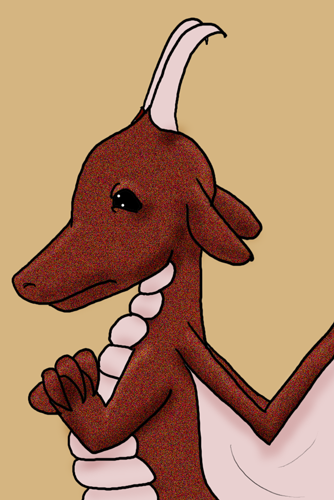





|
Elcenian Dragon
Range: Dragons are native to Elcenia. They live all over the world. Lifespan: 4,000 Elcenian years (2,930 Barashin years) This article is about the Elcenian species. For the Barashin species of the same name, see Barashin dragons. Dragons, quadrupedal winged reptiles with long necks and tails (in their natural shapes), are the longest-lived species in Elcenia. They may die unexpectedly of old age at any time between age 2,000 and age 4,000, with 2,600 being the median. They reach adult proportions (and are considered adults) at age 200, but throughout their lives, they grow one foot per decade (and begin at about two feet in length, so a thousand year old dragon is roughly 102' long from nose to tail). However, after learning to shapeshift (see dragon magic for more on this and other dragon abilities) they spend more of their time in other forms. They live all over the world, and almost invariably integrate themselves into societies belonging to the species whose appearances they adopt. Dragons can speak any language, but they have one of their own called Draconic, which no one who lacks a linguistic capacity comparable to theirs can master. They are notoriously close-mouthed on the subject of religion, and outsiders are unable to determine what, if anything, they believe about deities and similar topics with regard to Elcenia. (They have no special skepticism regarding Barashin gods). Because of their native crossfertility and high level of multicultural immersion, dragons are very likely to have children with members of other species. Half-dragons may be either thudias (more common) or parunias (functionally identical to full-blooded dragons). It is typical for a dragon to marry another dragon only after attaining a thousand years of age or more. Dragons have a long gestation period, followed by egg-laying in clutches of one to five, of which most eggs hatch (after a month of external incubation) but of which only about 20% of hatchlings survive to a month of age. The cause of death is unknowninsufficient dragon magic to sustain the hatchling's life. Dragons are loosely coordinated and governed by a body called the Dragon Council, which controls Dragon Island and consists of a representative from each color. The council has the authority to make and enforce laws over dragons everywhere, but these powers are rarely deployed and they serve as more of a cultural governing body than a legal one (performing marriages, keeping genealogical archives, offering matchmaking services, etcetera). Dragon colors are as follows:
Color group (column in the chart) affects an individual's dragon magic. Two dragons of different colors who have children may produce offspring of like color to either, slightly favoring the mother. Dragons breathe flames of a color that matches their scales. Metallic dragons produce scales that are made of the corresponding metal (e.g. gold dragon scales are made of gold), but while still on the dragon, scales are tougher and more resistant to the elements than the natural metal or a detached scale would be. Different colors of dragons also have different shapes, especially regarding horns, spines, and spikes, which will not be described here. Violet-group dragons differ more from non-violets than non-violets differ from each other. Violet-groups hatch out of larger eggs with tough, but flexible, membranes that must incubate underwater; they emerge from these eggs later but two feet longer, and are two feet longer than others of the same age throughout their lives. There are (mildly disparaging) words referring to non-members of any given color group: the nearest translations of the Draconic terms are "cold" for a non-red, "numb" for a non-green, "stuck" for a non-blue, "dry" for a non-violet, "blur" for a non-black, and "darkling" for a non-white.
The following characters are dragons (list does not include characters who hatched as shrens):
| ||||||||||||||||||||||||||||||


